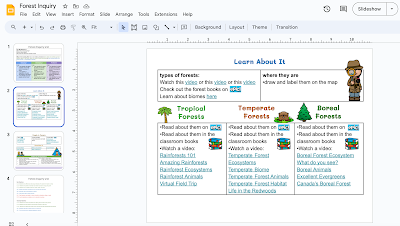Using Inquiry-Based Learning in the Classroom
Hey, y’all! I’m back for another episode of inquiry-based learning in the classroom with some examples and ways to get you started. It can be daunting to try to fit it all in, but we’ve been pretty successful, so I thought I’d share a little about what we do.Typically, we do a big phenomenon-based learning unit that encompasses all subject areas and use inquiry-based learning strategies throughout the unit to guide our instruction. If you’re not familiar yet with phenomenon-based learning, it’s a teaching strategy used in Finland with great success. I wrote a blog post about it that you can find here.
I am currently teaching first grade, and if you know first graders, they have a LOT of questions. When I plan our units, I start with their questions and go from there. So, that could look like choosing a topic to focus on like forests or patterns and creating questions (or observations) either informally (think “I wonder…” statements) or formally with a QFT session. Then, using those questions and observations to guide our learning.
In the forest example, we had our overarching theme. And since we live near Lake Tahoe, which is surrounded by forests, we used what we knew to begin our questions and explored different topics related to the forest.
Some of the things we learned about were different types of forests (Lake Tahoe is temperate), the different animals and plants we’d find in these different forests/habitats, what these plants and animals need and how it differs from forest to forest. We looked at maps of forests, learned about jobs people do to protect the forest, the average temperatures of different kinds of forests, and so much more.
In this case, since I had first graders and we needed some guidance, we did a structured inquiry where I took the questions they had and made lessons that focused on one area of their questions a day. So, when the kids asked about the animals in the Lake Tahoe region, that’s what we learned about that day.
To make it more inquiry-based and less lecture or sit-and-get, I put together learning plans in Google Classroom ™ so the kids could do their own research and report back to the class what they found. I also had books, maps, and other items available to the kids to explore as they learned more. We even had a park ranger come in and talk to the class. The level of questions they asked her blew us both away! Through their research and learning they had a whole host of higher-level questions than either of us ever expected. It was inspiring to watch!
So, in this unit, we hit science standards with plants, animals, habitats, needs/wants, food webs, types of forests, adaptations, and more. We hit math standards with looking at the area of the different forests and comparing the numbers. We also looked at temperature and tracked the changes with graphs. We hit reading standards with informational texts, comparing texts, finding main idea and supporting details, and looking at different text features. And we hit social studies standards when we looked at the jobs people do to take care of the forests and the economic impacts forests have on the surrounding areas. Y’all, this is first grade! If my first graders can do all this, your students can, too.
No, my kids are not savants. I simply made the resources accessible to them by creating digital learning plans that linked to Epic! Books and videos that gave them more information. We did read alouds and discussed A LOT of what we found so that, if there were any misunderstandings, we were able to clear them up quickly and share our findings with the rest of the class. Below is an example of a learning plan I've used with first graders.
At the end of the unit, the kids got to show what they learned by creating either a poster or a book about the topic. In this case, they picked a forest and shared everything they learning on it. We displayed their finished products around the classroom and did a gallery walk to check out what everyone did.
The kids were so proud of their accomplishments and everything they learned. This year, when we do our gallery walk, I’ll be inviting parents in to see exactly what it is we did and all the amazing ways the kids are able to apply their learning to reading, writing, art, and more.
I know you’re asking, “But how do we fit all this in?! This is so much!” Next week, I’ll be providing some more details on how I setup our units and how you can fit it all in with everything else we have to do. This is the exciting part so stay tuned for more!
Thanks for stopping by and have a wonderful week. I’ll talk to you soon.
Stay cozy,




No comments
Post a Comment